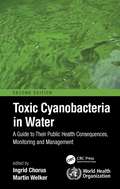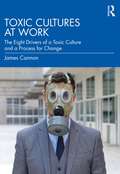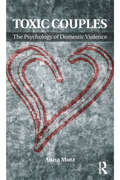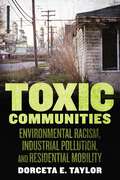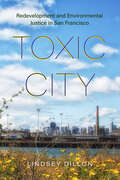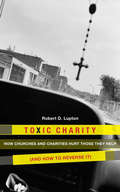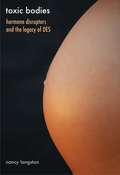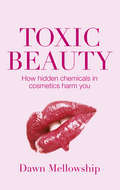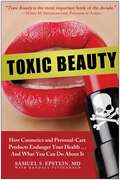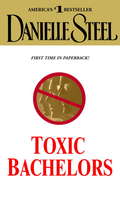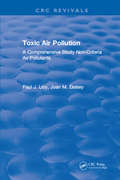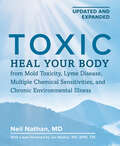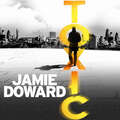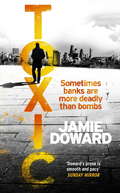- Table View
- List View
Toxic Cyanobacteria in Water: A Guide to Their Public Health Consequences, Monitoring and Management (Studies In The Growth Economies Of Asia #Vol. 18)
by Martin Welker Ingrid ChorusCyanobacterial toxins are among the hazardous substances most widely found in water. They occur naturally, but concentrations hazardous to human health are usually due to human activity. Therefore, to protect human health, managing lakes, reservoirs and rivers to prevent cyanobacterial blooms is critical. This second edition of Toxic Cyanobacteria in Water presents the current state of knowledge on the occurrence of cyanobacteria and cyanotoxins as well as their impacts on health through water-related exposure pathways, chiefly drinking-water and recreational activity. It provides scientific and technical background information to support hazard identification, assessment and prioritisation of the risks posed by cyanotoxins, and it outlines approaches for their management at each step of the water-use system. It sets out key practical considerations for developing management strategies, implementing efficient measures and designing monitoring programmes. This enables stakeholders to evaluate whether there is a health risk from toxic cyanobacteria and to mitigate it with appropriate measures. This book is intended for those working on toxic cyanobacteria with a specific focus on public health protection. It intends to empower professionals from different disciplines to communicate and cooperate for sustainable management of toxic cyanobacteria, including public health workers, ecologists, academics, and catchment and waterbody managers. Ingrid Chorus headed the department for Drinking-Water and Swimming-Pool Hygiene at the German Environment Agency. Martin Welker is a limnologist and microbiologist, currently with bioMérieux in Lyon, France.
Toxic Cultures at Work: The Eight Drivers of a Toxic Culture and a Process for Change
by James CannonAround the world and across industries, toxic workplaces are in the news. Taking a holistic approach, this book gives a succinct summary of how toxic cultures develop and shows how they can be remedied with practical takeaways for organisations. Existing books on toxic culture either skim the surface of the latest scandal or take a theoretical approach of limited use to practitioners trying to improve their organisations. Now, organisational development expert James Cannon presents an all-in-one resource based on organisational and individual psychology research that offers actionable suggestions for required change. Cannon provides a framework to understand the complexities of a toxic culture, identifying eight drivers: power, leadership personalities, values, organisation design, formal and informal systems, relations with the external environment and individual systems of motivation and reward. The book also offers a comprehensive toolkit with questionnaires and checklists to manage and achieve cultural change. Professionals and students in organisational psychology, business, and change management, as well as those with an interest in the political and social issues raised by toxic cultures, will appreciate this guide on how to tackle a problem that is much discussed but seldom solved.
Toxic Couples: The Psychology Of Domestic Violence
by Anna MotzDomestic violence is a major public health concern, affecting millions worldwide. It is underreported, often devastating and sometimes ends in murder. In Toxic Couples: The Psychology of Domestic Violence, Anna Motz integrates psychological and criminological data with clinical illustrations and discussion of current high-profile cases. She examines the complex manifestations and multiple causes of intimate partner violence. Motz disentangles the roles played by those involved and examines the addictive nature of these damaging partnerships. The book describes various forms of abuse, including physical, sexual and emotional, and analyses how intimate partner violence can escalate to murder. She explores important factors including: the role of addiction; homelessness and vulnerability; the intergenerational transmission of abuse; sadomasochistic relationships; honour-based violence. The book emphasizes the significance of female- as well as male-perpetrated violence and outlines the powerful impact on the children of abusive parents, extending the clinical awareness of professionals working with those affected. Toxic Couples: The Psychology of Domestic Violence is ideal for clinicians working with the victims and perpetrators of intimate partner violence, for students of psychology, gender studies and social care courses and for anyone interested in the psychological forces behind violence in relationships.]
Toxic Communities: Environmental Racism, Industrial Pollution, and Residential Mobility
by Dorceta TaylorUncovers the systemic problems that expose poor communities to environmental hazardsFrom St. Louis to New Orleans, from Baltimore to Oklahoma City, there are poor and minority neighborhoods so beset by pollution that just living in them can be hazardous to your health. Due to entrenched segregation, zoning ordinances that privilege wealthier communities, or because businesses have found the ‘paths of least resistance,’ there are many hazardous waste and toxic facilities in these communities, leading residents to experience health and wellness problems on top of the race and class discrimination most already experience. Taking stock of the recent environmental justice scholarship, Toxic Communities examines the connections among residential segregation, zoning, and exposure to environmental hazards. Renowned environmental sociologist Dorceta Taylor focuses on the locations of hazardous facilities in low-income and minority communities and shows how they have been dumped on, contaminated and exposed.Drawing on an array of historical and contemporary case studies from across the country, Taylor explores controversies over racially-motivated decisions in zoning laws, eminent domain, government regulation (or lack thereof), and urban renewal. She provides a comprehensive overview of the debate over whether or not there is alink between environmental transgressions and discrimination, drawing a clear picture of the state of the environmental justice field today and where it is going. In doing so, she introduces new concepts and theories for understanding environmental racism that will be essential for environmental justice scholars. A fascinating landmark study, Toxic Communities greatly contributes to the study of race, the environment, and space in the contemporary United States.
Toxic City: Redevelopment and Environmental Justice in San Francisco
by Lindsey DillonToxic City presents a novel critique of postindustrial green gentrification through a study of Bayview-Hunters Point, a historically Black neighborhood in San Francisco. As cities across the United States clean up and transform contaminated waterfronts and abandoned factories into inviting spaces of urban nature and green living, working-class residents—who previously lived with the effects of state abandonment, corporate divestment, and industrial pollution—are threatened with displacement at the very moment these neighborhoods are cleaned, greened, and revitalized. Lindsey Dillon details how residents of Bayview-Hunters Point have fought for years for toxic cleanup and urban redevelopment to be a reparative process and how their efforts are linked to long-standing struggles for Black community control and self-determination. She argues that environmental racism is part of a long history of harm linked to slavery and its afterlives and concludes that environmental justice can be conceived within a larger project of reparations.
Toxic Childhood: How The Modern World Is Damaging Our Children And What We Can Do About It
by Sue PalmerOne in six children in the developed world is diagnosed as having 'developmental or behavioural problems' - this book explains why and shows what can be done about it.Children throughout the developed world are suffering: instances of obesity, dyslexia, ADHD, bad behaviour and so on are all on the rise. And it's not simply that our willingness to diagnose has increased; there are very real and growing problems.Sue Palmer, a former head teacher and literacy expert, has researched a whole range of problem areas, from poor diet, lack of exercise and sleep deprivation to a range of modern difficulties that are having a major effect: television, computer games, mobile phones. This combination of factors, added to the increasingly busy and stressed life of parents, means that we are developing a toxic new generation.TOXIC CHILDHOOD illustrates the latest research from around the world and provides answers for worried parents as to how they can protect their families from the problems of the modern world and help ensure that their children emerge as healthy, intelligent and pleasant adults.
Toxic Childhood: How The Modern World Is Damaging Our Children And What We Can Do About It
by Sue PalmerOne in six children in the developed world is diagnosed as having 'developmental or behavioural problems' - this book explains why and shows what can be done about it. Children throughout the developed world are suffering: instances of obesity, dyslexia, ADHD, bad behaviour and so on are all on the rise. And it's not simply that our willingness to diagnose has increased; there are very real and growing problems. Sue Palmer, a former head teacher and literacy expert, has researched a whole range of problem areas, from poor diet, lack of exercise and sleep deprivation to a range of modern difficulties that are having a major effect: television, computer games, mobile phones. This combination of factors, added to the increasingly busy and stressed life of parents, means that we are developing a toxic new generation.TOXIC CHILDHOOD illustrates the latest research from around the world and provides answers for worried parents as to how they can protect their families from the problems of the modern world and help ensure that their children emerge as healthy, intelligent and pleasant adults.
Toxic Childhood: How The Modern World Is Damaging Our Children And What We Can Do About It
by Sue PalmerChildren throughout the developed world are suffering: instances of obesity, dyslexia, ADHD, bad behaviour and so on are all on the rise. And it's not simply that our willingness to diagnose has increased; there are very real and growing problems. Sue Palmer, a former head teacher and literacy expert, has researched a whole range of problem areas, from poor diet, lack of exercise and sleep deprivation to a range of modern difficulties that are having a major effect: television, computer games, mobile phones. This combination of factors, added to the increasingly busy and stressed life of parents, means that we are developing a toxic new generation. TOXIC CHILDHOOD illustrates the latest research from around the world and provides answers for worried parents as to how they can protect their families from the problems of the modern world and help ensure that their children emerge as healthy, intelligent and pleasant adults.
Toxic Chemicals: Risk Prevention Through Use Reduction
by Thomas E. Higgins Jayanti A. Sachdev Stephen A. EnglemanCatastrophic events such as the Bhopal, India tragedy and rising incidences of cancer in areas neighboring industrial facilities have heightened concern over the use of toxic chemicals in manufacturing and industry. Based on the authors' research conducted in Sao Paulo, Brazil, this book explores the history of toxic chemical release reporting programs, presents data on the toxicity of chemicals currently in use, discusses variables that contribute to the relative toxicity of a substance, compares existing programs for reducing environmental threats, and provides specific recommendations for reducing or eliminating the use of toxic chemicals.
Toxic Chemical and Biological Agents: Detection, Diagnosis and Health Concerns (NATO Science for Peace and Security Series A: Chemistry and Biology)
by Joseph H. Banoub Giovanni Sindona Maria Luisa Di GioiaThis book critically assesses the current state of knowledge on new and important detection technologies, e.g. mass spectrometry, tandem mass spectrometry, biosensor detection and tissue imaging, in connection with toxic chemical and biological agents. In general, the main topics discussed concern the risks and consequences of chemical and biological agents for human health in general, with special emphasis on all biochemical and metabolic pathways including the reproductive system. The exposome, genetic risks and the environment, various health hazard agents, risk assessment, environmental assessment and preparedness, and analysis of sub-lethal effects at the molecular level are also discussed. In closing, the book provides comprehensive information on the diagnosis of exposure, and on health concerns related to toxic chemical and biological agents.
Toxic Charity: How the Church Hurts Those They Help and How to Reverse It
by Robert D. LuptonPublic service is a way of life for Americans; giving is a part of our national character. But compassionate instincts and generous spirits aren't enough, says veteran urban activist Robert D. Lupton. In this groundbreaking guide, he reveals the disturbing truth about charity: all too much of it has become toxic, devastating to the very people it's meant to help. In his four decades of urban ministry, Lupton has experienced firsthand how our good intentions can have unintended, dire consequences. Our free food and clothing distribution encourages ever-growing handout lines, diminishing the dignity of the poor while increasing their dependency. We converge on inner-city neighborhoods to plant flowers and pick up trash, battering the pride of residents who have the capacity (and responsibility) to beautify their own environment. We fly off on mission trips to poverty-stricken villages, hearts full of pity and suitcases bulging with giveaways-trips that one Nicaraguan leader describes as effective only in "turning my people into beggars." In Toxic Charity, Lupton urges individuals, churches, and organizations to step away from these spontaneous, often destructive acts of compassion toward thoughtful paths to community development. He delivers proven strategies for moving from toxic charity to transformative charity. Proposing a powerful "Oath for Compassionate Service" and spotlighting real-life examples of people serving not just with their hearts but with proven strategies and tested tactics, Lupton offers all the tools and inspiration we need to develop healthy, community-driven programs that produce deep, measurable, and lasting change. Everyone who volunteers or donates to charity needs to wrestle with this book.
Toxic Capitalism: Corporate Crime and the Chemical Industry (Routledge Revivals)
by Steve Tombs Frank PearceOriginally published in 1998. While there is a growing academic literature on corporate crime, much of this focuses upon variants of economic or financial crimes; there is a relative absence of studies of safety, health and/or environmental crimes. This is curious given that recent years have witnessed a resurgence in popular, academic and indeed state attention to questions related to environmental degradation and human safety. Certainly in the latter context there is some recognition that environmental degradation must be understood partly in terms of environmental crimes by corporations. Moreover, recent experience in both the US and the UK attests to the fact that there is no ineluctable trend towards safer and healthier workplaces, as deregulatory movements have resulted in increased risks for most workers and, this text argues, an increased opportunity for, and incidence of, safety crimes. At the centre of environmental, safety and health isses lie the chemicals industries. These industries are of strategic importance to national economies, while also having almost unique hazard and risk potential and it is for these reasons that these are the focus of this text. Any understanding of the nature of these types of corporate crimes, and thus any recognition of the potential for their more effective regulation, requires an analysis that is grounded in more general sociological concerns and in political economy. For this reason, this text emphasises the need for understandings of the nature of contemporary and emergent forms of corporate organisation, of their place in contemporary economies, and of the relationships between these forms and state formations.
Toxic Bodies: Hormone Disruptors and the Legacy of DES
by Nancy LangstonIn 1941 the Food and Drug Administration approved the use of diethylstilbestrol (DES), the first synthetic chemical to be marketed as an estrogen and one of the first to be identified as a hormone disruptor--a chemical that mimics hormones. Although researchers knew that DES caused cancer and disrupted sexual development, doctors prescribed it for millions of women, initially for menopause and then for miscarriage, while farmers gave cattle the hormone to promote rapid weight gain. Its residues, and those of other chemicals, in the American food supply are changing the internal ecosystems of human, livestock, and wildlife bodies in increasingly troubling ways. In this gripping exploration, Nancy Langston shows how these chemicals have penetrated into every aspect of our bodies and ecosystems, yet the U. S. government has largely failed to regulate them and has skillfully manipulated scientific uncertainty to delay regulation. Personally affected by endocrine disruptors, Langston argues that the FDA needs to institute proper regulation of these commonly produced synthetic chemicals.
Toxic Beauty: The hidden chemicals in cosmetics and how they can harm us
by Dawn MellowshipEvery year we each absorb an estimated 2 kilograms of chemicals through beauty and cosmetic products. Chemicals found in lipsticks, skin lotions and hair dyes have been linked with tumours, cell mutation, allergies, reproductive complications, endocrine disruption and cancer. Isn't it time we all paid more attention to exactly what goes into the eye shadows, body washes and deodorants we love to use? This compelling and timely book tells you the key chemicals you should avoid, reveals just how natural 'organic' beauty products really are, and features a directory highlighting the health issues surrounding a wide range of products, from hair gel to sunscreens.
Toxic Beauty: The hidden chemicals in cosmetics and how they can harm us
by Dawn MellowshipEvery year we each absorb an estimated 2 kilograms of chemicals through beauty and cosmetic products. Chemicals found in lipsticks, skin lotions and hair dyes have been linked with tumours, cell mutation, allergies, reproductive complications, endocrine disruption and cancer. Isn't it time we all paid more attention to exactly what goes into the eye shadows, body washes and deodorants we love to use? This compelling and timely book tells you the key chemicals you should avoid, reveals just how natural 'organic' beauty products really are, and features a directory highlighting the health issues surrounding a wide range of products, from hair gel to sunscreens.
Toxic Beauty: How Cosmetics and Personal-Care Products Endanger Your Health... and What You Can Do About It
by Samuel S. EpsteinSplashy ads and commercials for personal care products are everywhere we turn, promising to keep our appearances fresh and our partners satisfied. But do consumers really know what they're applying to their faces and bodies in their quests for youth and beauty? Do they know the health risks they're taking by simply applying lipstick, face moisturizer or deodorant? Toxic cosmetics and personal care products clutter the shelves at retail stores everywhere, and consumers don't know the avoidable risks they're taking by following a simple beauty regimen. Written by Dr. Samuel S. Epstein, a founder and chairperson of the Cancer Prevention Coalition, Toxic Beauty gives the lowdown on salon safety, health risks hiding in everyday products, how we put our children in danger and more. Toxic Beauty will also educate you and your family on easily implemented solutions through the use of a variety of positive alternatives. Through the help of Dr. Epstein and Toxic Beauty, you can protect yourself from the possible long-term effects of a simple beauty product.
Toxic Bachelors
by Danielle SteelDanielle Steel explores the perils of dating, relationships, and love in a novel that takes us into the intoxicating, infuriating world of three charming single men, also known as... Toxic Bachelors They were the best of friends and the most daunting of bachelors....Charlie Harrington, a handsome philanthropist, has such high expectations for his perfect bride that no mortal need apply....Adam Weiss, a forty-something celebrity lawyer, prefers his women very young, very voluptuous, and very short-term....And for Gray Hawk, a gifted artist with a knack for attracting troubled relationships, women are fine; it's just the idea of family he can't imagine (particularly the family of the woman he's dating). Now the three friends, spending their annual summer vacation cruising the Mediterranean aboard Charlie's majestic yacht, are about to have their bachelorhood rocked. By autumn all three will fall precipitously into relationships they never saw coming. Charlie begins dating a crusading social worker who couldn't be further from his ideal-until he makes a stunning discovery about her. Adam gets involved with his usual twenty-something bombshell-only this one has a remarkable mind of her own. And Gray, who has avoided both business and family like the plague, has managed to fall head over heels for a successful career woman- who just happens to be a mother as well. As another holiday on the yacht approaches, and with it a turning point in each man's life, the three bachelors are forced to face the things that scare them most: their phobias about relationships, the wounds of the past-and the kind of women who challenge their deepest terrors. What happens next will spark big changes for Charlie, Adam, and Gray-and might just put an end to their carousing days forever. For as the once-carefree trio is about to discover, love is the most unpredictable adventure of all. Filled with all the joy, complexity, and unexpected surprises of life, Toxic Bachelors is Danielle Steel at her poignant and penetrating best.From the Hardcover edition.
Toxic Air Pollution: A Comprehensive Study Non-Criteria Air Pollutants
by Paul J. LioyThe difficulties with addressing toxic air pollutants are the cheer number of compounds present in the atmosphere and their sources. The purpose of this book is to develop an approach to understanding toxic air pollutants through synthesis of the scientific results obtained in the Airbourne Toxic Element and Organic Substance (ATEOS) project.
Toxic 2nd Edition: Heal Your Body from Mold Toxicity, Lyme Disease, Multiple Chemical Sensitivities, and Chronic Environmental Illness
by Neil NathanDr. Neil Nathan introduces fresh insights, updated information, and vital medical breakthroughs in this second edition of his bestselling book.Millions of people are suffering from chronic illnesses that, unbeknownst to them, are the result of exposure to environmental toxins and infectious agents such as mold and Borrelia, which causes Lyme disease. Millions. Because the symptoms of these illnesses are so varied and unusual, many of these individuals have sought medical care only to be dismissed, as if what they are experiencing is &“in their head.&” Many (if not most) have tried to tough it out and continue to function without hope of improvement. Unfortunately, their illnesses are very real. The new edition of Toxic offers renewed hope for patients, their loved ones, and the physicians who care for them. Dr. Neil Nathan delves deeper into the harmful impact of chronic inflammation in driving disease and presents the latest information that can help both doctors and patients achieve faster and more complete healing. He has also expanded the chapter on mold toxicity, as it is increasingly recognized as a leading cause of complex illnesses.Drawing on decades of experience helping thousands of patients regain their health, even when other doctors had lost hope, Dr. Nathan continues to refine his understanding of the common causes of debilitating illnesses, leading to more precise and effective treatments. This updated edition sheds even more light on these complex conditions, offering patients and their families the crucial support they need.Key updates include:· The latest testing and treatments in every chapter· Major medical breakthroughs in the identification and treatment of Lyme disease· An expanded section on the diagnosis and treatment of mold toxicity· A dedicated chapter on COVID-19· A comprehensive chapter on the health effects of electromagnetic fields (EMFs)· A full chapter on new discoveries related to environmental toxinsReaders will have access to the comprehensive range of topics explored in the original edition, including:· Information about how extreme sensitivity and toxicity develop in the body, how sensitivity and toxicity differ, and how they often overlap· Detailed descriptions of each of the five major causes of extreme sensitivity and toxicity: mold, Bartonella (a co-infection of Lyme disease), mast cell activation, porphyria, and carbon monoxide poisoning· An outline of the cell danger response, a revolutionary model developed by Dr. Robert Naviaux that explains how the body essentially gets "stuck" fighting a threat even after the danger has passed· A system-by-system plan for "rebooting" the body to break the cycle of illness and allow healing to begin· Information about coping with stress and embracing an emotional and/or spiritual awakening on the path to wellness
Toxic (Pretty Little Liars #15)
by Sara ShepardToxic is the fifteenth--and second-to-last--volume in Sara Shepard's #1 New York Times bestselling Pretty Little Liars series, also a hit ABC Family original TV show. <P> High school seniors Aria, Emily, Spencer, and Hanna barely survived their most recent encounter with A. And it's not over yet.... The police don't believe that the real A is still out there, but the girls know what--and who--they saw. If they don't track down this final tormentor soon, A will silence them forever.This penultimate installment of the beloved series is full of juicy scandals, dark secrets, and shocking plot twists that will prepare readers for the jaw-dropping series conclusion in Pretty Little Liars #16.
Toxic (Pretty Little Liars #14)
by Sara ShepardHigh school seniors Aria, Emily, Spencer, and Hanna barely survived their most recent encounter with A. And it's not over yet . . . The police don't believe that the real A is still out there, but the girls know what - and who - they saw. If they don't track down this final tormentor soon, A will silence them forever.This penultimate installment of the beloved series is full of juicy scandals, dark secrets, and shocking plot twists that will prepare readers for the jaw-dropping series conclusion in Pretty Little Liars No 16.
Toxic (Dark-Hunter World)
by Jamie DowardThe mutilated body of a senior banker is found on a remote Kent beach. Could the man's death be linked to the scandal engulfing his employer, a global investment bank created by the CIA to help it track terrorism financing? Kate Pendragon, a financial analyst seconded to MI5, discovers that the bank is close to collapse, something that threatens to bring down the CIA. Elsewhere, intelligence is gathered on an Islamic terrorist cell intent on triggering a nuclear catastrophe to rig the world's financial markets – rigged, it would appear, by the Americans. But will rogue agents in the CIA really allow the disaster to happen in order save their bank? Pendragon believes the intelligence community on both sides of the Atlantic could be falling for a sophisticated hoax. Only, no one is listening to her. And the clock is ticking...
Toxic
by Carol Ericson"That's the way I like it-hot and wet."Not something I'd typically say in a job interview, but it just kind of slipped out. I blame Ronnie Tate-the woman is sin in stilettos. As bosses go, the sexy ex-showgirl is way more appealing than the Miami billionaire who hired me to find his missing mistress.The girl's trail ends at Ronnie's bayside bar, so I've got to get close to the people there to find out more. And I plan to get real close to Ronnie in particular. She's hiding plenty-like why she's clinging to this dump her late husband left her, and why her employees keep disappearing. If I have to expose more than just Ronnie's secrets, so much the better.Slinging drinks isn't private investigator J. P. McCoy's usual MO. But nothing is what it seems in this sultry noir tale of blackmail, murder, sex and scandal.If you love heart-stopping suspense and fearless romance, look for Carol Ericson's Harlequin Intrigue title The Hill available now!
Toxic
by Jamie DowardThe mutilated body of a senior banker is found on a remote Kent beach. Could the man's death be linked to the scandal engulfing his employer, a global investment bank created by the CIA to help it track terrorism financing? Kate Pendragon, a financial analyst seconded to MI5, discovers that the bank is close to collapse, something that threatens to bring down the CIA. Elsewhere, intelligence is gathered on an Islamic terrorist cell intent on triggering a nuclear catastrophe to rig the world's financial markets - rigged, it would appear, by the Americans. But will rogue agents in the CIA really allow the disaster to happen in order save their bank? Pendragon believes the intelligence community on both sides of the Atlantic could be falling for a sophisticated hoax. Only, no one is listening to her. And the clock is ticking...
Toxic
by Jamie DowardThe mutilated body of a senior banker is found on a remote Kent beach. Could the man's death be linked to the scandal engulfing his employer, a global investment bank created by the CIA to help it track terrorism financing? Kate Pendragon, a financial analyst seconded to MI5, discovers that the bank is close to collapse, something that threatens to bring down the CIA. Elsewhere, intelligence is gathered on an Islamic terrorist cell intent on triggering a nuclear catastrophe to rig the world's financial markets – rigged, it would appear, by the Americans. But will rogue agents in the CIA really allow the disaster to happen in order save their bank? Pendragon believes the intelligence community on both sides of the Atlantic could be falling for a sophisticated hoax. Only, no one is listening to her. And the clock is ticking...
